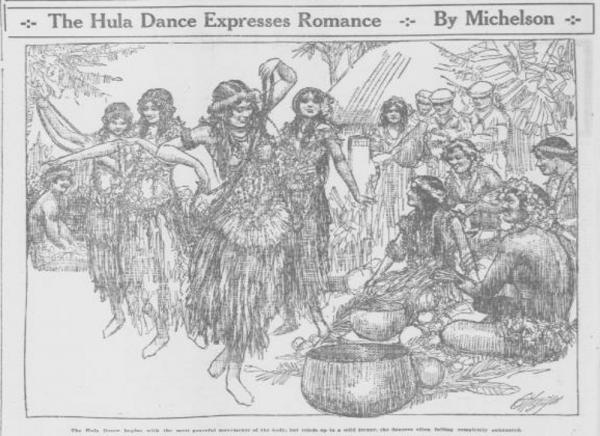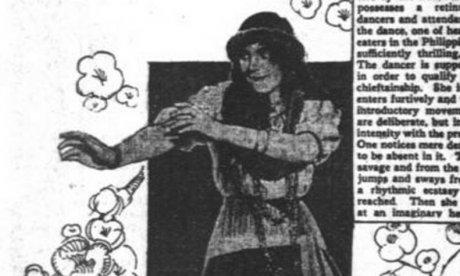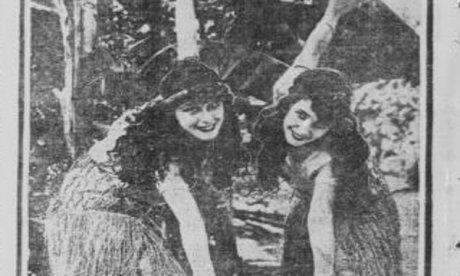Chronicling America Dispatches: Hula on the Mainland United States

El Paso herald. (El Paso, Tex.) 1901-1931, April 17, 1913, Image 2
Image provided by University of North Texas; Denton, TX http://chroniclingamerica.loc.gov/lccn/sn88084272/1913-04-17/ed-1/seq-2/

El Paso herald. (El Paso, Tex.) 1901-1931, April 17, 1913, Image 2
Image provided by University of North Texas; Denton, TX http://chroniclingamerica.loc.gov/lccn/sn88084272/1913-04-17/ed-1/seq-2/
From time to time, we will highlight dispatches from our state partners participating in the National Digital Newspaper Program, a joint sponsorship between the National Endowment for the Humanities and the Library of Congress to create a national, digital resource of historically significant newspapers published between 1836 and 1922, from all states and U.S. territories. The following dispatch comes from our Hawaiian state partner, the University of Hawaii, Manoa.
What do people outside of Hawaii usually think about the Aloha State? Haunted tikis? The gorgeous, sunny beaches? Coconut trees? Pineapples? Maitais at tiki bars? Or sensual hula dancers in coconut bras and grass skirts?
In the 1800s and 1900s, the Hula 'Auana, the westernized hula, developed, with melodic songs, string instrument accompaniment, and sensual gestures. Hula dancers performed on tourist shows and Hollywood films, introducing mainland Americans to the feminized version of Hawaii.
In the 1890s and early 1900s, hula dancers and Hawaiian musicians toured the U.S. mainland. Usually women, the dancers danced in their grass skirts, while accompanying musicians played their kitschy Hawaiian melody on their steel guitars and ukulele. American newspapers reported hula dancing and people's perceptions of hula, and advertisements showed where and when hula dancers performed.
The Hawaiian entertainers performed at the 1893 Chicago World’s Columbian Exposition and other American world fairs in 1899 (Omaha), 1901 (Buffalo), 1909 (Seattle), 1915 (San Francisco), and 1939 (New York). For Seattle and San Francisco, the Hawaii Pineapple Growers' Association sent women with Hawaiian and Caucasian ancestry to give and promote pineapples to fair goers.
While mainland audiences revered the hula dancers, people at home didn't approve of their dancing. When the dancers got back home, some of them received scorn from strangers.
For example, Sisters Lei and Kashinano Lokalani (pictured in the gallery) danced the hula at the 1916 San Diego Exposition. They earned the respect of prominent people, such as a presidential candidate and the president of the Women's Clubs of America. The sisters even got a contract to perform around the country for a vaudeville organization.
However, according to the Hawaiian promotion committee, S.M. Lowery from Honolulu was "thoroughly disgusted" with the performance. He said the dance was not hula at all and was more like the "hoochi-koochi Chicago Midway Fair fame." The committee says the hula is a "disgrace and a blot upon the fair name of territorial Hawaii." However, the sisters' father explained he would not allow his daughters to dance the "real Hawaiian hula," as its nature (presumably sexual) would probably not be approved.
In 1922, the Arizona State Fair decided not to feature hula and "every objectionable show and concession." The article reported, "it's au revoir to the Hoochi Koochi show, and the can has been tied to the naughty can-can, likewise to the con man and the thousand and one games of chance."
In 1899, the Independent, a pro-Hawaiian newspaper, complained about the stereotypes of Hawaii perpetuated by the hula dancers at the Greater American Exposition in Omaha, Nebraska:
"We think it is a pity that Hawaii should be placed on exhibition as a semi-barbarous country to draw tourists to Honolulu. The visitors at Omaha may believe that the village and the semi-nude girls and the beer-voiced singers are representative of life in Hawaii, and they might come here to see the 'fun' and be disagreeably surprised to find modern buildings, well lighted streets, telephones and rubber-tired hacks, and the hulas under strict police supervision. They will find that the Hawaiian women dress very much like their sisters on the mainland, only a little more expensive; that they don't wear skirts made of ti leaves, and that to many of them the hula is an unknown dance."
Further reading in Chronicling America
"Good-Bye to the Hula-Hula Girl"
Mohave County miner and our mineral wealth., October 06, 1922, Automobile Section, Page PAGE FOUR, Image 12
"Tourist Travelling"
The Independent., July 12, 1899, Image 2
"No Hula-Hula Monkey Business" (opinion)
The St. Louis Republic., July 26, 1903, PART I, Image 8
"The Hula Hulas: They Stride Their Steeds in the Park"
The morning call., June 05, 1893, Page 10, Image 10
"Drops Straw Garb in Her Hula Dance"
The Washington times., June 06, 1919, FINAL EDITION, Page 4, Image 4
"Hula-hula dances scientifically investigated at last"
New-York tribune., January 23, 1910, Page 3, Image 53
"The Hula Dance Expresses Romance"
El Paso herald., April 17, 1913, Image 2
"The Hui of Native Hawaiian Dance"
The Washington herald., January 14, 1912, Magazine Section, Image 31

